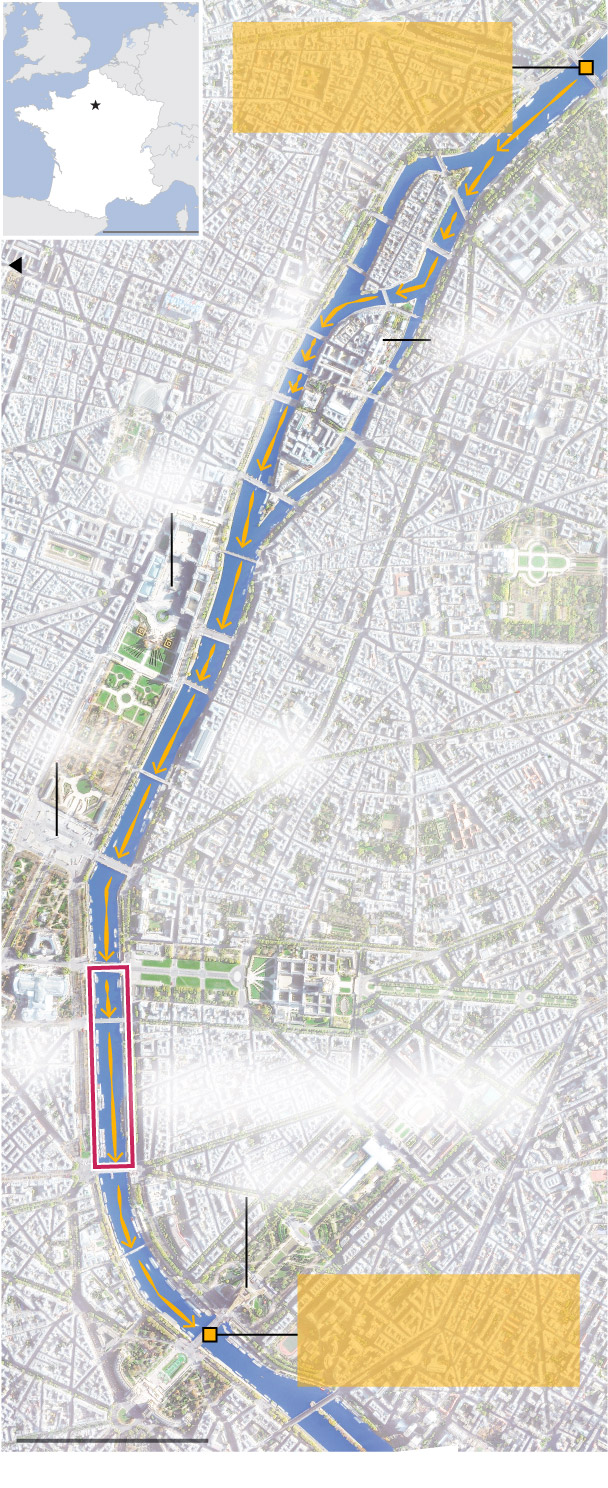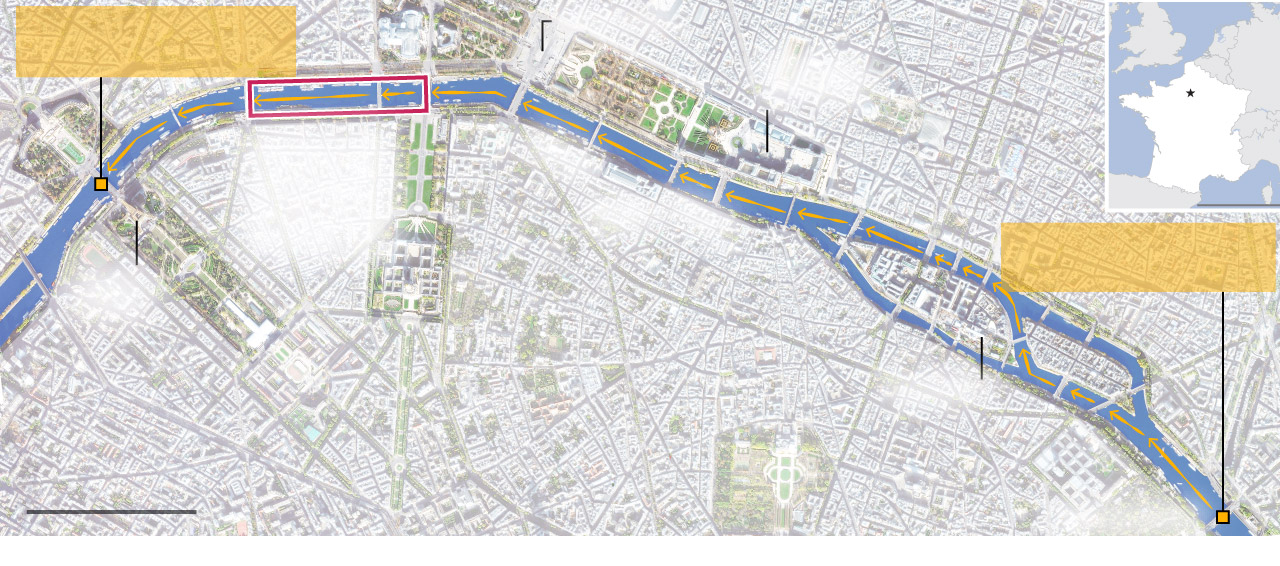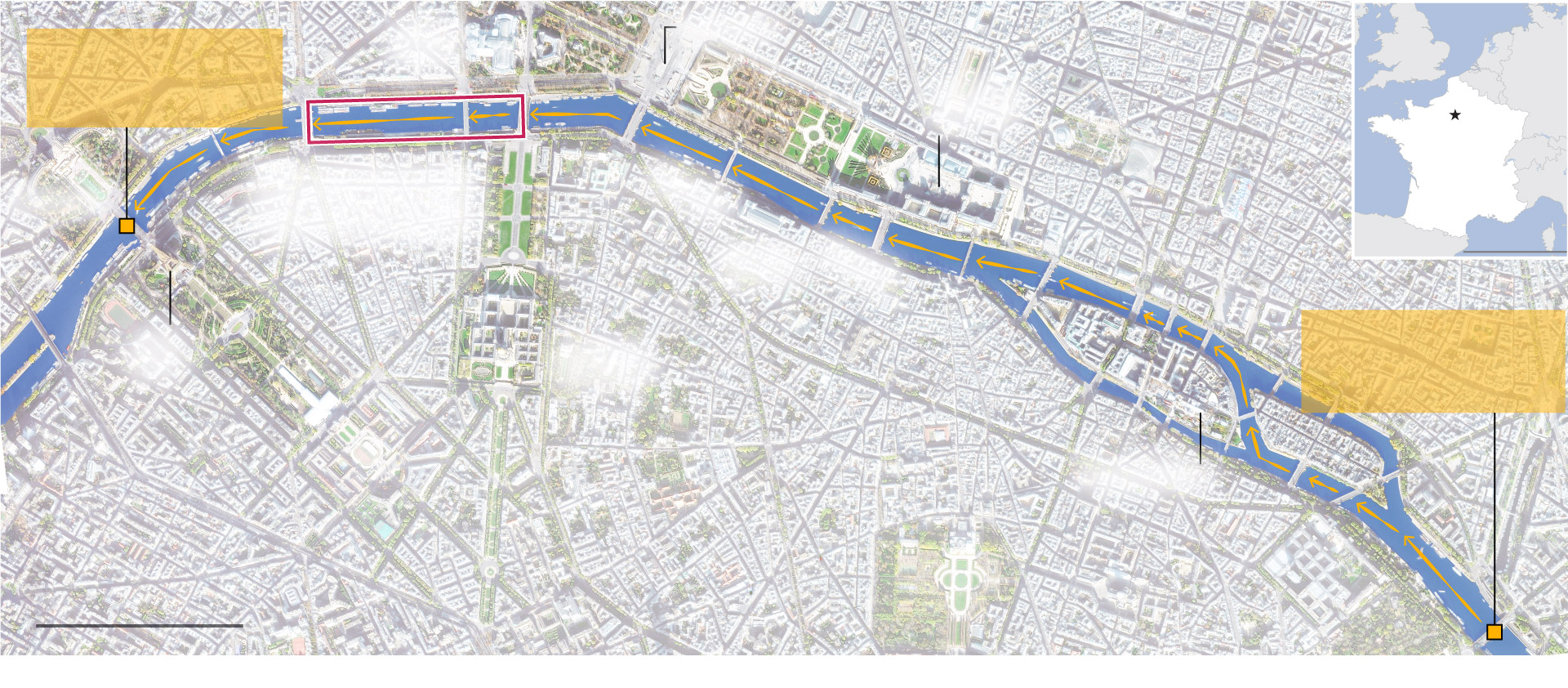The Paris Olympics’ Seine River plan is bold, audacious … and risky

PARIS — By day, the Seine River winds gracefully through the city’s center, but as darkness falls, the Seine turns from turquoise to indigo to inky black until it glows with reflections of the city lights. Many call the Seine the world’s most romantic river, and beneath the Pont d’léna, a man waits beside a red carpet lined with burning candles and a row of letters that spell “Marry me.” Two violinists play nearby. Behind them, the Eiffel Tower shimmers bright white.
More than 400 years ago, the Pont Neuf, just upstream, opened up the river’s splendor. Before then, the Seine had been Paris’s lifeblood — its birthplace on the Île de la Cité, its workhorse, its gateway to the world. But with the Pont Neuf, “the romance of the river began,” says Joan DeJean, the author of “How Paris Became Paris: The Invention of the Modern City.” At last, Parisians could “gaze for a long distance down the river [and] admire the panorama and the beauty of the great architecture that lines both banks.”
(Toni L. Sandys/The Washington Post)
(Toni L. Sandys/The Washington Post)
(James Cornsilk for The Washington Post)
Ever since, the Seine has dazzled in a way no river can, becoming what DeJean calls a “marketing tool.”
“For many people, Paris wouldn’t be Paris without the Seine,” she says.
Now the organizers of this summer’s Paris Olympics want to make the Seine the star of their Games with an audacious plan to host the Opening Ceremonies not inside a stadium as other Olympics have done but on the river itself.
They imagine a sunset parade of athletes riding dozens of river cruise boats three miles down the Seine...
to a makeshift amphitheater at the Trocadero across the water from the Eiffel Tower for an extravaganza on the river with acrobats, light shows, drone displays and dancers on nearby rooftops.
They also plan to stage some long-distance swimming events in the river even though the Seine has teemed with garbage and rancid toilet water for decades. They are counting on the French government’s 1.4 billion euro project to make the river swimmable for the first time in nearly 100 years.
They say they are doing this because a French Olympics should be stylish and stunning and something no one will forget. After two Olympics amid pandemic restrictions and with television ratings dipping and perhaps interest in the Games waning, the International Olympic Committee needs a sensational Olympics and Opening Ceremonies, too.
But the line between phenomenal and reckless can be precariously thin. Paris’s great remaking of what an Olympics should look like comes with risk. The city has a long history of suffering from terrorist attacks, and a ceremony on the river with more than a half-million spectators in the open sounds alarms for security experts. And there are no guarantees the water-cleaning project will be finished in time … or even work.
“It’s an Opening Ceremonies — you’re talking about billions of TV viewers [and] hundreds of thousands of spectators — so, yes, if everything goes wrong, people will see it,” Paris 2024 CEO Etienne Thobois says.
Or as Jennifer Minner, a Cornell University professor who studies the impacts mass events such as Olympics and world’s fairs have on their host cities, wonders. “The world is watching. Paris is onstage. Will it be a disaster?”
Less than seven months remain before the Olympics begin. Paris’s ambitions are huge, and yet are its dreams too bold?
“The Seine in Paris is pretty particular,” Thobois says, sitting in his office at the Paris 2024 headquarters in the nearby suburb of Saint-Denis. “This is probably the one city where the river is not an impediment because of the 37 bridges that cross it. You go to St. Petersburg [Russia]: If you missed the last one which comes up, then you need to do 80 kilometers to get onto the other side or you need to swim. Even the Thames is not an easy crosser. Paris, we have those 37 bridges, which brings you to another part of the city like this.”
He snaps his fingers.
“So it’s not an obstacle,” he continues. “It’s a part of the life.”



MORE THAN A QUARTER-CENTURY AGO, Thobois was a member of the French badminton team at the Atlanta Olympics. Now, in middle age, with glasses and a graying beard, he sits imposingly behind his desk, describing in English how the Seine was not originally a big part of Paris 2024’s plan. The city’s original bid, made to the IOC in 2016, called for a traditional ceremony in the Stade de France, but after being awarded the Games and lining up existing stadiums for events, organizers looked to find temporary facilities for other sports, hoping to cut costs.
“And then some crazy ideas started to come up,” Thobois says.

They placed the beach volleyball stadium under the Eiffel Tower and found iconic sites for other sports: equestrian at the Palace of Versailles and fencing at the Grand Palais. And as the IOC added more of what it calls “urban sports,” such as skateboarding, breaking and three-on-three basketball, Paris organizers imagined a park for them at Place de la Concorde.
Then in 2018, when Buenos Aires held a lavish Opening Ceremonies for the Summer Youth Olympics not in a stadium but on the city’s streets, Paris 2024 officials watched and wondered. Could they do the same?
“We wanted that Opening Ceremonies to be as special as possible,” Thobois says. “We wanted it to be as open as possible, and we wanted to do something different. And then the river being what it is, and in Paris it came quite naturally to [Paris 2024’s director of brand, creativity and engagement] Thierry Reboul, who is a very creative guy [and] said: ‘Why don’t we do that on the river?’
(Bertrand Guay/AFP/Getty Images)
(Reuters)
(Bertrand Guay/AFP/Getty Images)
Triathletes dive in the Seine river during a test event this past summer to prepare for the Olympics.
A heavy rain can overwhelm Paris’s sewer system, sending pollution into the river.
Organizers hope their mitigation efforts will make the river safe for swimming, but they acknowledge that in a worst-case scenario, the triathlon might be turned into a duathlon.
“Right now our job is to make sure that the probabilities are high that the swimming leg can take place,” Thobois says. “But [a cancellation] can always happen.”
“Everybody recognized there was a challenge, and the question was, ‘Are we able to deliver on that challenge?’ ” he continues. “It was not just a decision that was taking a piece of paper and coming from out of a crazy mind. It probably started like that, but definitely it was something [on which] we are still spending a lot of time.”
Finally, in 2021, with less than three years before the Olympics, he said the Paris 2024 organizers had looked at all the plans, read all the security studies and listened to all the experts. Only then, Thobois says, did they look at each other in a meeting and say: “This is crazy. Let’s do this.”

FROM THE BANKS NEAR THE CITY CENTER, it’s easy to see why the Seine hasn’t been fit for swimming. Bottles and cans gather in oily pools near the stone walls that line the water. Restaurant barges dump wastewater directly into the river. People cast fishing lines in the water, but actually seeing fish in the green, murky muck is nearly impossible. Rainstorms, though, are the Seine’s real polluter. A heavy rain can overwhelm the city’s aging sewers quickly, mixing runoff stained by the streets with sewage already in the pipes, sending the whole festering mess into the river.
(Toni L. Sandys/The Washington Post)
(James Cornsilk for The Washington Post)
(James Cornsilk for The Washington Post)
Construction is ongoing for what Paris hopes will be the solution: a huge, cavernous basin just two blocks from the Seine on the Left Bank, tucked between the Austerlitz train station and a hospital that dates back to the 1600s.
Above ground, the only indication of the basin is scaffolding around a concrete circle...
but beneath sprawls a massive room, nine stories tall, lined with pillars that dwarf a bulldozer still chewing on the bottom.
Eventually, it will be the size of 20 Olympic swimming pools.
Connected to the basin will be a tunnel several blocks long, stretching from the 13th Arrondissement under the Seine to the river’s Right Bank.
When construction is completed, storm water will pour into the tunnel and the basin. Later, the water will drain back into the sewer at a manageable pace.
There are other parts to the water-clearing project, including the construction of three other basins in the distant suburbs downstream, the renovation of two sewage treatment plants, a push to get residents near the Seine not yet hooked to the city’s sewers to do so and to mandate the restaurant barges connect to the sewers, something that reportedly only half have done.
But engineering and increased awareness offer no guarantees, as was demonstrated in August, when officials had to cancel the swimming portion of a Paralympic triathlon test event as well as a two-day swimming event because bacteria levels exceeded the safe limits. The city blamed a faulty valve in the system that allowed an excessive amount of sewage into the river. Thobois noted that some days’ events were allowed to take place and that a particularly heavy period of rain late last summer sent dirty runoff into the Seine. This, he pointed out, won’t happen when the Austerlitz basin is complete.
“When you add up all those things and that we realized that we could swim two days and we were quite close the other days, we feel very comfortable in the fact that all the efforts that were put into cleaning the river for the last four or five years are going to pay off,” he said.
So much can still go wrong. The mitigation measures might not work. The reservoir could fail. A summer of more big rains could be too much for the new system. Races could be delayed for days.
Watching from afar, Minner is skeptical. She is accustomed to seeing great public projects for big events that did little to help those cities. The $13 billion spent on the 2016 Rio de Janeiro Olympics, with its legacy of crumbling, rarely used stadiums and arenas built for the Games, stand as the perfect example of what she calls “promises not met.”
The Seine cleanup, which is being funded by France and several municipalities, raises some of the same concerns. She worries that much of the work will clean the waters only in the city’s center, the tourist places and not other parts of the river that flow through the lower income and immigrant neighborhoods. Will the Seine be swimmable in those places as well?
“Long term it’s difficult to answer how well [the project] will work,” Minner says. “If it fails during the Olympics, it will be remembered as a large-scale failure, but that could be overcome by the permanent benefits that are realized over time.”

STILL, ORGANIZERS MAY FACE NO BIGGER CHALLENGE than protecting the Opening Ceremonies. In the eyes of security experts, the walls of stadiums and arenas create boundaries with limited entrances at which all entrants can be screened. By comparison, a ceremony sprawling for miles in the city center is a nightmare to defend.
France’s Interior Ministry promises 35,000 French police who, along with 2,000 Paris police officers and at least another 2,000 private security workers, will protect the parade and ceremony along with what Interior Ministry official Gerald Darmanin told Le Monde will be “an anti-terrorist perimeter.” But the country is familiar with the dangers of terrorism.

In November 2015, militant extremist groups staged a series of attacks, including suicide bombings just outside what will be the main Paris Olympic stadium, the Stade de France, during a French national soccer team match and a mass shooting at a concert at the Bataclan theater. In all, 130 people were killed and more than 400 others injured.
Former U.S. Homeland Security secretary Michael Chertoff believes France is “quite skilled in intelligence and police service,” but he nonetheless sees worries everywhere.
“If you look at what’s going on around the world now, you’d be hard-pressed to feel complacent,” says Chertoff, now the executive chairman of his own security company, the Chertoff Group. “A shooter is always a risk. A bomb is always a risk.
“Drones are a relatively new problem. It might be [that] one of the things you need to do is restrict the ability of drones to fly over the airspace you’re dealing with and then have a rule that if a drone does enter that airspace, it gets destroyed. So, I mean, I do think you’re going to have to adapt or plan for the possibility of some kind of drone attack.”
France’s National Assembly also has approved the use of limited artificial intelligence to monitor crowds and identify threats. Paris 2024 President Tony Estanguet says the Games and French officials are “committed” to “a very strong security process like never before in our country” during the Olympics, pointing out that Paris routinely has New Year’s and Bastille Day celebrations with hundreds of thousands of people.


“I feel that we wouldn’t do anything stupid,” Thobois says. “But at the same time, we wouldn’t just let it go because it’s not a challenge, because it’s a challenge. Everybody recognized that there was a challenge and the question was, are we able to deliver on that challenge? And the answer after one year and a half of studies was, yes, we can take that up.”
As Thobois sits in his office, he knows that no matter how well he and others may have planned for next summer’s Olympics a lot can still go wrong. Doesn’t he worry this could all be a disaster?
He looks perturbed.
“We’re conscious of that,” he says. “Do we worry like that? Our job is to worry about everything.”
He pauses and looks out the window behind his desk, at the top of the Eiffel Tower and the spires of the Sacre-Coeur on Montmartre and the skyscrapers in La Defense, then turns back around.
“I think we are ambitious,” he continues. “But we are very thorough in our approach. We like to think we actually are not taking any chances.”

correction
A previous version of this story incorrectly described the Pont Neuf as downstream from the Eiffel Tower, and said the Pont Neuf was the Seine River’s first bridge.



